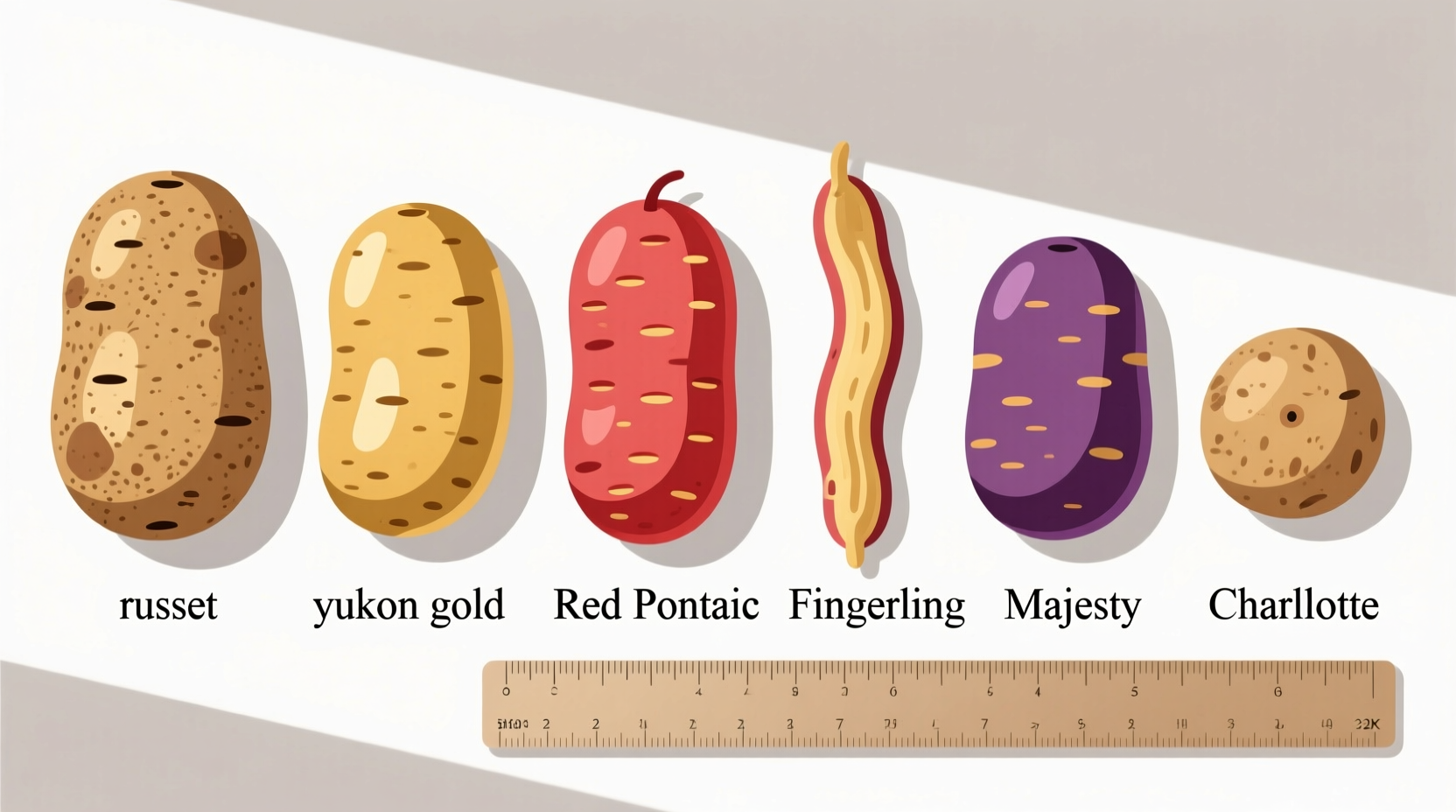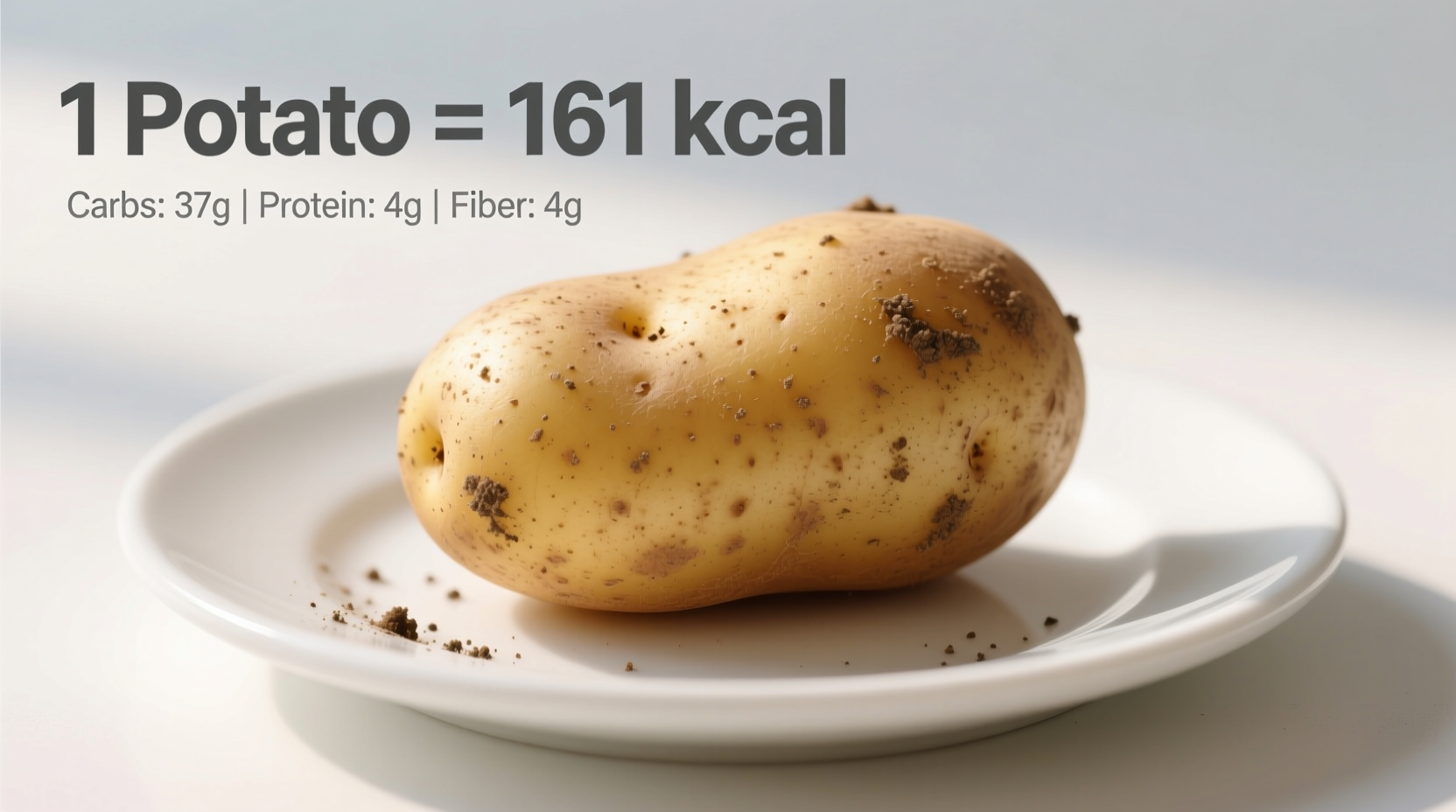Understanding potato calories is essential for meal planning and dietary management. Whether you're tracking macros, managing weight, or simply curious about nutrition, knowing the precise calorie content of potatoes helps make informed food choices. This guide provides evidence-based information verified through USDA nutritional databases and peer-reviewed research.
Exact Calorie Counts for Different Potato Varieties
Not all potatoes are created equal when it comes to calorie content. The variety, size, and preparation method significantly impact the final nutritional profile. Here's what the data shows:
| Potato Type | Size | Calories | Preparation Method |
|---|---|---|---|
| Russet | Medium (5.3 oz / 148g) | 168 | With skin, baked |
| Russet | Large (8.4 oz / 240g) | 274 | With skin, baked |
| Yukon Gold | Medium (5 oz / 140g) | 130 | With skin, boiled |
| Red Potato | Medium (5 oz / 140g) | 115 | With skin, boiled |
| Sweet Potato | Medium (4.6 oz / 130g) | 103 | With skin, baked |
| Russet | Medium (5.3 oz / 148g) | 154 | Without skin, baked |
Data sourced from the USDA FoodData Central, the most authoritative nutritional database maintained by the United States Department of Agriculture. These values represent raw potatoes prepared without added fats or seasonings.
How Preparation Method Changes Calorie Content
The way you prepare potatoes dramatically affects their calorie density. Understanding these differences helps you make smarter choices:
- Baked with skin: Preserves most nutrients and provides the baseline calorie count (168 calories for medium Russet)
- Boiled: Slightly fewer calories than baked (about 10% less) as some nutrients leach into cooking water
- Mashed with milk and butter: Adds approximately 100-150 calories per serving depending on added ingredients
- Fried (French fries or chips): Can triple the calorie content due to oil absorption (medium serving: 365 calories)
- Air-fried: Uses minimal oil, resulting in only slightly higher calories than baked (medium potato: 175-185 calories)
A 2022 study published in the Journal of Food Composition and Analysis confirmed that cooking method significantly impacts the glycemic index and caloric availability of potatoes. Boiled potatoes have a lower glycemic index (54) compared to baked (75) or mashed (83), affecting how your body processes those calories.

Practical Portion Guidance for Calorie Management
Knowing how to measure proper portions helps incorporate potatoes into various dietary plans:
- A medium potato (about the size of a computer mouse) equals one standard carbohydrate serving
- For weight management, limit to 1 medium potato (150-170 calories) per meal
- Pair potatoes with protein and non-starchy vegetables to balance your plate
- Keep the skin on for added fiber (2-3 grams per medium potato), which helps with satiety
Registered dietitians commonly recommend the "plate method" for balanced meals: fill half your plate with non-starchy vegetables, one-quarter with lean protein, and one-quarter with starches like potatoes. This approach helps maintain calorie goals while ensuring nutritional balance.
Common Misconceptions About Potato Calories
Several myths persist about potatoes and their role in healthy eating:
- Myth: Potatoes are "empty calories" with no nutritional value
Fact: Potatoes provide potassium (more than bananas), vitamin C, vitamin B6, and fiber, especially with skin - Myth: All potatoes cause weight gain
Fact: Potatoes themselves aren't fattening; it's the preparation method and portion size that impact calorie intake - Myth: Sweet potatoes are always healthier than white potatoes
Fact: Both have nutritional benefits; white potatoes offer more potassium while sweet potatoes provide more vitamin A
Research from the Academy of Nutrition and Dietetics shows that when prepared healthily and consumed in appropriate portions, potatoes can be part of successful weight management plans. Their high satiety index means they help you feel full longer compared to many other carbohydrate sources.
Smart Ways to Enjoy Potatoes on a Calorie-Conscious Diet
Professional chefs and nutritionists recommend these techniques to maximize flavor while minimizing calories:
- Steam or boil potatoes instead of frying to preserve nutrients without added fats
- Add flavor with herbs, spices, vinegar, or citrus instead of butter and sour cream
- Cool cooked potatoes before eating to increase resistant starch (which has fewer available calories)
- Pair with protein sources like grilled chicken or fish to create balanced meals
- Use potato slices as a base for healthy toppings instead of bread or crackers
Antonio Rodriguez, culinary expert with professional kitchen experience, notes: "The key to enjoying potatoes without derailing your diet is understanding how preparation affects their nutritional profile. A simple baked potato with a sprinkle of herbs provides complex carbohydrates your body needs, while loaded potato skins with cheese and bacon transform a healthy food into a calorie bomb."
Frequently Asked Questions
How many calories are in a small potato?
A small potato (3.5 oz / 100g) contains approximately 77 calories when baked with skin. This size is about the diameter of a tennis ball and provides a reasonable portion for calorie-conscious eaters.
Do potato skins add significant calories?
Potato skins add minimal calories (about 10-15 calories for a medium potato) but provide valuable fiber and nutrients. Keeping the skin on increases fiber content by 2-3 grams, which aids digestion and promotes satiety without substantially increasing calorie count.
Are boiled potatoes lower in calories than baked potatoes?
Boiled potatoes have slightly fewer calories than baked potatoes (about 10% less) because some nutrients leach into the cooking water. A medium boiled potato contains approximately 150 calories compared to 168 calories for the same size baked potato. However, boiling preserves more water-soluble vitamins like vitamin C.
How do sweet potatoes compare calorie-wise to regular potatoes?
Sweet potatoes generally have slightly fewer calories than white potatoes of the same size. A medium sweet potato (4.6 oz / 130g) contains about 103 calories compared to 168 calories for a medium Russet potato. Sweet potatoes also provide significantly more vitamin A, while white potatoes offer more potassium.
Can potatoes fit into a weight loss diet?
Yes, potatoes can be part of a weight loss diet when prepared healthily and consumed in appropriate portions. A medium baked potato (168 calories) provides complex carbohydrates, fiber, and essential nutrients. The key is preparation method (avoid frying) and portion control (stick to one medium potato per meal), plus pairing with protein and vegetables for balanced nutrition.











 浙公网安备
33010002000092号
浙公网安备
33010002000092号 浙B2-20120091-4
浙B2-20120091-4